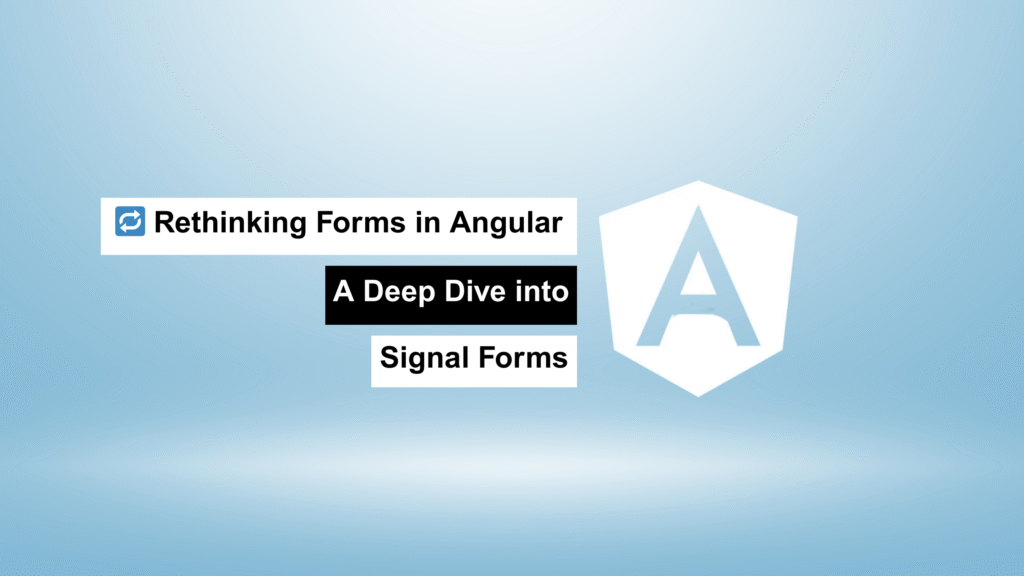
Angular’s new Signal Forms are flipping the script on how we handle form state. Instead of the form owning the data, you own the model — and the form simply reflects it. If you’ve used Angular’s reactive forms before, this approach might feel like a breath of fresh air.
In this post, I’ll break down what Signal Forms are, how they work, and why they matter — especially if you’re looking for cleaner, faster, and more maintainable forms in Angular.
📦 What Are Signal Forms?
At its core, Signal Forms bring a model-first approach powered by Angular’s signal reactivity system. Instead of managing state inside FormGroup or FormControl, you define your data model using WritableSignal, and the form mirrors it.
✅ The Big Idea:
Your model is the single source of truth.
The form reads from it, writes to it, and updates reactively — no middleman, no sync headaches.
💡 Example: An Order Form
Let’s say we’re building a simple order form with multiple line items.
interface LineItem {
description: string;
quantity: number;
}
interface Order {
orderId: string;
items: LineItem[];
}
// Define the model using signal()
const orderModel = signal<Order>({
orderId: 'ORD-123',
items: [
{ description: 'Ergonomic Mouse', quantity: 1 },
{ description: 'Mechanical Keyboard', quantity: 1 }
]
});
This is a standard WritableSignal<Order>. Now, let’s turn this into a reactive form.
🧠 Introducing the form() Function
const orderForm: Field<Order> = form(orderModel);
Calling form() on your signal turns it into a Field<T> structure — a deeply reactive mirror of your model.
Here’s what that gives you:
orderForm.itemsis aField<LineItem[]>orderForm.items[0]is aField<LineItem>orderForm.items[0].quantityis aField<number>
You now have a form structure that exactly matches your model, and it’s powered by Angular signals under the hood.
🧩 Meet the Field<T> Object
The Field object is the backbone of Signal Forms. Think of it like a reactive wrapper around each part of your form.
Each field exposes its internal state through the $state property:
field.$state = {
value: WritableSignal<T>;
valid: Signal<boolean>;
errors: Signal<FormError[]>;
disabled: Signal<boolean>;
touched: Signal<boolean>;
};
🔍 What These Mean:
value: Two-way bound signal with your modelvalid: Boolean signal showing validityerrors: Array of validation errorsdisabled: Reactive flag for disabled statetouched: Tracks user interaction
These reactive pieces give you complete control over the form in a clean and type-safe way.
🛠 Navigating the Field Structure
Once you’ve got the form set up, accessing nested fields is super intuitive:
const itemsField = orderForm.items;
const firstItemField = orderForm.items[0];
const quantityField = orderForm.items[0].quantity;
Every part of the form is deeply connected to your model. Update the model, the form updates. Update the form, the model syncs — instantly.
🤯 Why Signal Forms Matter
Here’s why I’m personally excited about Signal Forms:
✅ You stay in control of your data
🔄 Two-way syncing is built-in and transparent
🧼 No more FormGroup, FormControl, or nesting boilerplate
🚀 Fine-grained reactivity = real performance gains
This is Angular embracing declarative, reactive patterns—without ditching type safety or structure.
📌 Quick Recap
form()turns yoursignal<T>model into a reactive form tree.Field<T>objects represent your form fields — deeply nested and reactive.- Everything is driven by signals: validation, touched states, errors, and more.
- Signal Forms are a lean, powerful alternative to traditional Angular Reactive Forms.
If you’re tired of verbose form code, messy control nesting, or constant syncing between form and model — Signal Forms are 100% worth exploring.
Have you started using Signal Forms yet? I’d love to hear how you’re integrating them into your workflow — drop your thoughts below
